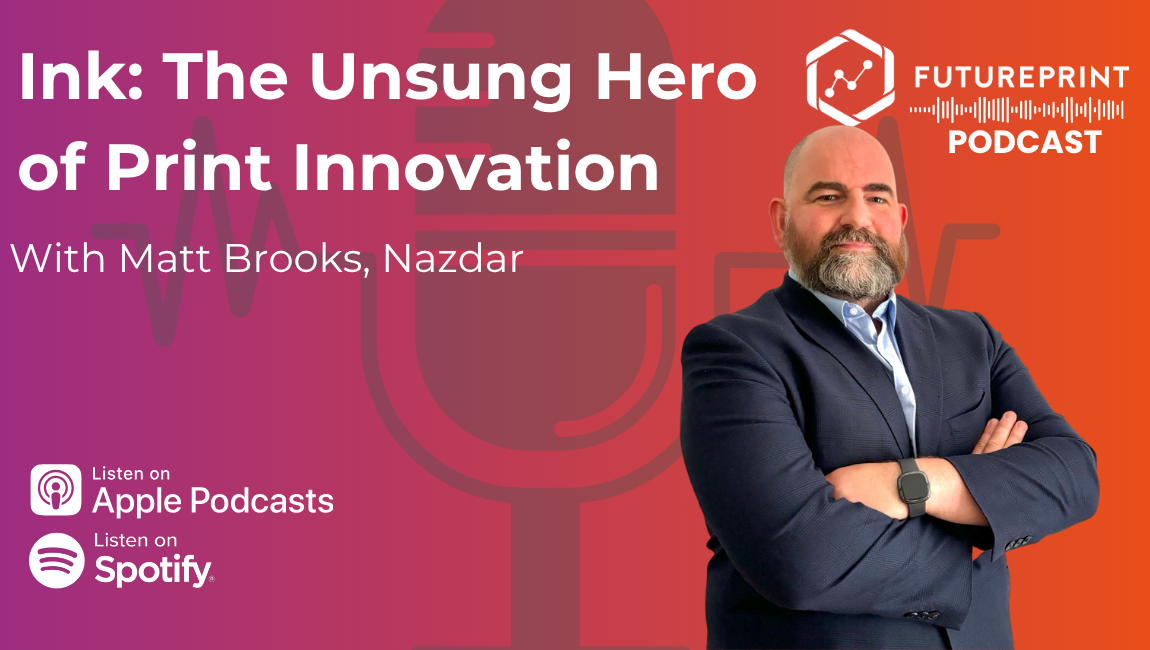Listening, Patience and Collaboration: Matt Brooks’ Vision for Digital Print at Nazdar
In a recent podcast, we enjoyed talking with Matt Brooks of Nazdar.
Matt’s career in print has been anything but conventional. Now leading business development strategy at Nazdar with a focus on packaging, he has spent more than 25 years pushing the boundaries of inkjet chemistry and application — from pioneering UV inkjet in wide format graphics to driving digital transformation in packaging. His story is one of curiosity, risk-taking, and a determination to focus on the essentials.
An Accidental Start in Print
Brooks’ introduction to the print industry was more serendipity than strategy. Fresh out of sixth form, he had planned to pursue sports journalism, but the introduction of university tuition fees made him rethink. Taking a year out, he landed a summer job with Mirage Inks in Somerset.
“I got introduced to chemistry, pigment dispersions, bead mills — and I actually enjoyed it,” Brooks recalls. Surrounded by talented mentors, he found himself drawn into the world of ink formulation. Mirage offered him a full-time role with day-release study, leading to a degree in colour chemistry from Leeds University.
That early experience also gave him a front-row seat to one of inkjet’s earliest government-funded R&D programmes — a formative exposure that sparked a lifelong interest in digital print.
Riding the UV Inkjet Wave
In the early 2000s, Brooks moved across the country to join Sericol Imaging, working as a chemist on UV inkjet projects. At the time, Sericol partnered closely with Inca Digital to develop the first wide format flatbed printers for retail and point-of-sale graphics.
UV inkjet was a revolution: replacing solvent-based printing, reducing emissions, and offering new levels of durability. “There was a whole buzz towards UV,” Brooks says, drawing a parallel with today’s excitement around water-based technologies. His role evolved from chemistry R&D to customer-facing technical support, giving him insight into market needs and OEM product development.
From Graphics to Packaging
The wide format market matured quickly, prompting Brooks to explore “what’s next?” The answer was packaging — a sector ripe for digital disruption. Like graphics in the 1990 & early 00’s, packaging was dominated by analogue processes such as flexo, litho and offset. Changing retail demands, shorter lead times, SKU proliferation and sustainability pressures made digital an attractive complement — and, in some cases, a replacement.
Brooks was heavily involved in developing single-pass inkjet solutions for folding carton and corrugated applications. He stresses that understanding converters’ pain points was key: “It’s not just about technology — it’s how that technology can leverage a customer’s business transformation.” His approach involved bringing converters into the development process early, ensuring systems were built to real-world specifications rather than purely technical ideals.
Why Single Pass Matters
For Brooks, single pass is essential for digital packaging’s breakthrough. While wide format remains valuable for certain applications, achieving “quality at speed” is critical for penetrating mainstream packaging production. That means moving beyond short runs into mid-volume sweet spots of 5,000–12,000 sheets, where digital can replace or complement analogue lines.
“Produce at scale digitally and the economies of scale work themselves out,” he says. “We can then offer the lowest cost per copy with the best value proposition.”
The Role of Materials in Innovation
Brooks believes ink and substrate considerations are still too often an afterthought in equipment design. “Having a chemistry provider involved in the design phase shouldn’t be abnormal,” he says. Involving ink and media partners early avoids costly compromises and accelerates development.
From colour targets to adhesion trade-offs, he sees materials science as inseparable from print performance — and a critical factor in achieving predictable, reliable production.
Joining Nazdar: Focus on Commercialisation
At Nazdar, Brooks’ remit is clear: bring innovative ink technologies — particularly high-viscosity UV and water-based solutions — to market in a way that accelerates digital adoption in packaging. This means focusing on smaller footprints, lower energy use, more efficient drying, and broader application ranges.
“Nazdar has the global footprint of a big company but the agility to respond quickly to customer needs,” he says. “That’s a big appeal for me.”
Collaboration, Patience and Listening
Asked about the future of inkjet, Brooks cites three essentials: listening, patience and collaboration.
“Digital will penetrate packaging, but we need to understand the process and the pain points. Listen with the intent to understand, not just respond. And why shouldn’t OEMs collaborate? Why can’t ink partners work together more effectively?”
It’s a philosophy that recognises the realities of entrenched analogue competition while pushing for a cooperative approach to accelerate innovation.
Lessons from the Strongman Arena
Outside of print, Brooks is a competitive strongman — a discipline that, surprisingly, has parallels with his professional life. “Strongman has taught me focus,” he explains. “You start with a huge range of possible events, but narrow down to the few you need to win. In business, there are endless opportunities, but you have to prioritise.”
Favourite events include the yoke carry (up to 400 kg on his back over 20 metres), farmer’s carries (110 kg in each hand), and the log press (110 kg overhead for reps). The sport also reinforces resilience — getting back up after setbacks — and the value of camaraderie, where competitors share knowledge to help each other improve.
A Measured Optimism for the Future
Despite economic uncertainty and industry consolidation, Brooks sees a bright future for inkjet in packaging — provided the industry can deliver cost-effective, high-speed, high-quality solutions at scale.
“Screen printing, flexo, litho — they’ll all still have their place,” he says. “But digital’s role will grow. With the right mix of listening, patience and collaboration, we can accelerate that growth and make digital mainstream in packaging.”

